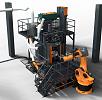Editor
- FMA
- The Fabricator
- FABTECH
- Canadian Metalworking
Social distancing and machine service
Machine tool suppliers discuss how serving customers is changing with the need to reduce physical interactions
- By Rob Colman
- April 9, 2020
- Article
- Health & Safety
With the rapid rise of COVID-19 cases in North America over the past few months, we have been introduced to a term that will likely be the expression of the year – social distancing. By encouraging people to go home and stay home, the medical community’s goal has been to stop the virus in its tracks. That creates challenges for those attempting to support essential service providers like fabricators. But in a way, machine tool builders and suppliers have been preparing for this for some time.
Here we have a look at how four suppliers in Canada have or are adapting to ensure their customers get the information and the service they need. A bigger question these changes raise long-term is, How will this change fabricators’ service expectations?
Wired and Ready
Amada is a good example of this distance communication preparedness.
“About 10 years ago we wired up all of our facilities for videoconferencing,” said Amada North America General Manager Nick Ostrowski. “We have been doing live feed demonstrations from those locations to customers in their facilities, but also at FABTECH. At FABTECH it’s useful because it allows us to demonstrate equipment that just isn’t practical to bring to the show floor, such as a large laser welding cell.”
Ostrowski sees this digital connection with customers as an extension of the company’s two philosophies of customer connection: “One to many” and “One to one.” One to many would describe Amada hosting an open house for many of its customers. One to one is holding a private demonstration for a customer, running the customer’s exact part and then performing a time study to verify the time savings and cost efficiencies Amada has calculated for the part.
“It’s fairly easy to transition to doing these demonstrations electronically,” said Ostrowski. “The only thing missing is the tactile ability for the customer to actually touch the parts we’ve made. In that case, we can cut the part, process it, and ship it overnight to the customer so they can inspect it as we run through a full demonstration.”
The company has been live streaming events on social media platforms for quite some time too.
“Our next shows will not be shows where customers come to us but shows where we come to them,” said Ostrowski.
As for customer consultations, Ostrowski said that the Amada team is doing as much as it can via videoconferencing through mobile devices, but that the technology can take you only so far.
“If you have to resolve a mechanical or hydraulic issue, you need a service person in the building,” he said. “Our service people are being asked to follow all the social distancing rules but continue to visit customers when absolutely necessary.”
Though this is a very unfortunate situation, Ostrowski pointed out that we’re fortunate that it happened now and not 20 years ago.
“We are fortunate that this happened at a time when the internet is robust enough to allow business to be transacted,” he said. “So much business would be at an absolute standstill today if that wasn’t the case.”
Live Demos and Video Training
Westway Machinery is one machine tool distributor that has been developing new ways to connect with its customers remotely several ways over the past few years.
According to Marketing Manager Matt Walter, the company’s service team has been using technologies such as TeamViewer and FaceTime to consult with customers for some time when it made sense.
“This is popular in situations where it's difficult to get to the customer site quickly. Problems often can be solved promptly and efficiently without a physical visit, especially for issues related to machine control programming,” he explained.
Walter also noted that sometimes customers are looking for tutorials on machines they already have in their shop. To serve that need, a few months ago the Westway team started developing short video tutorials that customers can watch at their own pace.
“They don’t want to have to read through a manual, but they also don’t want to have to come in for extra training if they can avoid it,” said Walter. “We’ve started developing these for some of the more conventional non-CNC machines. The value for the customer is that the videos are available to them later for training new or existing employees.”
The company is now offering one-on-one live feed demonstrations of machines on its shop floor for customers as well.
“As essential service providers, our customers need to get the job done regardless of social distancing rules,” said Walter. “Anything we can do to get the right machinery into their hands, and to keep that machinery running, we will do.”
Bolstered Phone Support
What Bystronic Canada Ltd. Managing Director Roberto Nicoli has been struck by in the past month or so is how appreciative customers have been that services such as web conferencing and video calls have been available.
“Like many others in this situation, customers understand that it is in our best interests not to meet in person, and they are pleased when they understand that we can accommodate that,” said Nicoli. “They have pointed out that not everyone is offering these services.”
Bystronic has introduced a lot of other initiatives to enhance customer communication and services. For instance, standard machine demonstrations are now running at set times and being live-streamed from showrooms in Switzerland, Germany, Italy, and the U.S. If a customer knows there is a certain machine they want to understand better, they can register for one of those. Individual customer demonstrations are also being set up so that customers can send the company a drawing and they can watch their parts being cut and bent live.
“Many more customers are signing up for these personalized demos,” said Nicoli.
The company has also tripled the number of people working its service hotlines.
“The lines are set up to serve people based on the type of machine they need help with,” said Nicoli.
In-house service calls, of course, are being made as necessary, once it’s clear that a facility is safe to visit.
“If for some reason it isn’t possible to visit a facility, we have developed what we call a ‘Technician in a Box,’ where we send the customer a box with an iPad and a router and we guide them through a troubleshooting session remotely with a dedicated specialist of our team,” said Nicoli.
As Nicoli explained, it’s all about ensuring shops can keep operating at full capacity.
“We have customers working in the ‘essential business,’ such as the medical industry, that can’t afford any downtime right now,” he said. “We want to make sure we do what we can for them.”
App Updates
TRUMPF Service Manager, Product Support Group Michael Otterbein noted that his company has continued to refine its Visual Assistance service to better help customers. If you visited the company’s booth at FABTECH the past couple years, you would have seen this service connected to the company’s Smart Glasses, which allow a technician to walk through an examination of a machine with a machine operator virtually. This now can be done by using a Visual Assistance app for Android and Apple platforms. Otterbein described it as “FaceTime with enhancements.”
“Its use is increasing as travel restrictions come into effect,” he said. “Being able to see what’s happening on the customer’s shop floor enhances what we can do remotely. With both the glasses and the app, we’re able to circle specific components, highlight them, and walk the customer through the solution. We can also upload and show them a schematic, for example. And being able to see what the operator sees, we might pick up on something they wouldn’t notice. For instance, we might see a blinking light on a module that indicates a problem they may not be aware of. Seeing what is happening on-site, in real time, allows us to use the years of TRUMPF experience and training we have to solve problems for our customer and reduce downtime.”
Otterbein has a team of 40 people dedicated to remote support.
“But if an issue can’t be solved remotely, we work to ensure that everything is properly prepared for when a service technician goes on their visit,” he said. “This ensures they have everything they need – the parts and the tools they will need to finish the job. This can mean less time at the customer’s facility, which is ideal.”
As part of that 40-person team, Otterbein recently added someone dedicated to what is known as the “condition monitoring centre.” For customers that agree to connect their machines to the cloud, TRUMPF can actively pull data from those machines to identify areas of concern and diagnose problems before customers necessarily know there’s an issue.
“We really believe that this sort of diagnostic work is the future of service. What can you do remotely? If we can increase our solution rate with these tools, we think that’s the way of the future. It’s been our long-term vision and we have been putting these tools in place over the last few years, never anticipating a situation where we would need to use them out of necessity like this. We’ve made it available to all our customers. They can get our app on the app store. In the background we’ve created accounts for all our customers so that if they do download the app, we can find them on our side right away and visually connect to them in minutes.”
TRUMPF is also setting up online training for those customers who have recently installed or are in the process of having a new machine installed.
“We’re creating three-hour webinars for the customers, accompanied by reading assignments. We would still want customers to come in for training after this is all over, but this gets them up and running with that equipment.”
The question is, will this pandemic prove to be the challenge that gets fabricators used to more online services? Ostrowski believes so.
“Up until six months ago, people would rather fly to California for a few days than watch a live video demonstration,” he said. “I think people are going to start to see how much more efficient it is to do business in this manner, not only time-wise but cost-wise, and this might push digital business communications over the hump.”
Editor Robert Colman can be reached at rcolman@canadianfabweld.com.
Amada Canada, www.amada.ca
Bystronic Canada, www.bystronic.ca
TRUMPF Inc., www.trumpf.com
Westway Machinery, www.westwaymachinery.com
About the Author

Rob Colman
1154 Warden Avenue
Toronto, M1R 0A1 Canada
905-235-0471
Robert Colman has worked as a writer and editor for more than 25 years, covering the needs of a variety of trades. He has been dedicated to the metalworking industry for the past 13 years, serving as editor for Metalworking Production & Purchasing (MP&P) and, since January 2016, the editor of Canadian Fabricating & Welding. He graduated with a B.A. degree from McGill University and a Master’s degree from UBC.
subscribe now


Keep up to date with the latest news, events, and technology for all things metal from our pair of monthly magazines written specifically for Canadian manufacturers!
Start Your Free Subscription- Trending Articles
FMA Annual Meeting: Ingenuity still key with tech innovations

Messer Canada hosts anniversary event

Welding jacket designed for protection, comfort

Compact swing chamber shot blast machine features robotic workpiece handling

Gang punching press system accommodates different parts quickly

- Industry Events
MME Saskatoon
- May 28, 2024
- Saskatoon, SK Canada
CME's Health & Safety Symposium for Manufacturers
- May 29, 2024
- Mississauga, ON Canada
DiPaolo Machine Tools Open House 2024
- June 4 - 5, 2024
- Mississauga, ON Canada
FABTECH Canada
- June 11 - 13, 2024
- Toronto, ON Canada
Zoller Open House & Technology Days 2024
- June 12 - 13, 2024
- Ann Arbor, MI
















